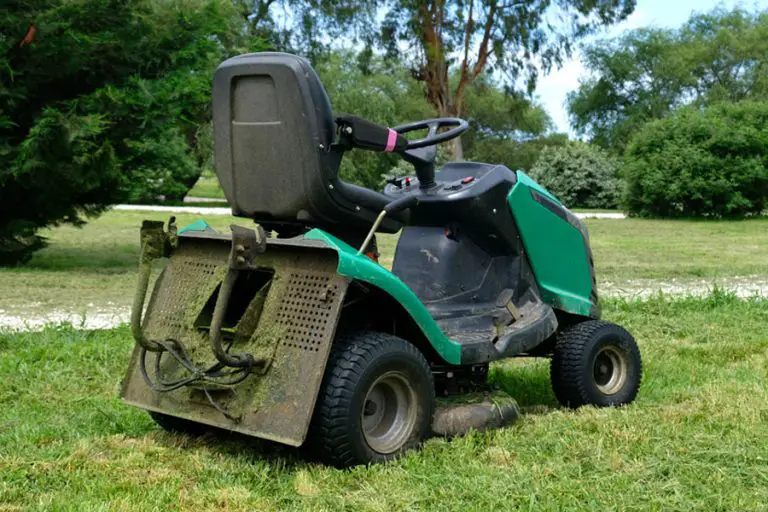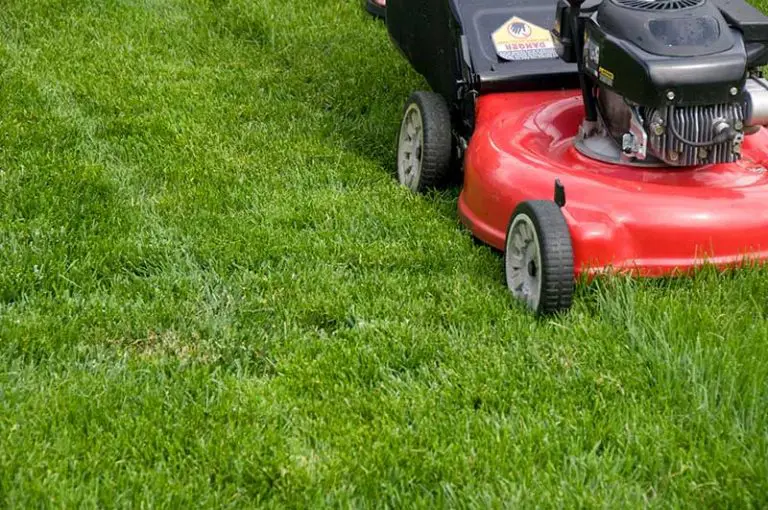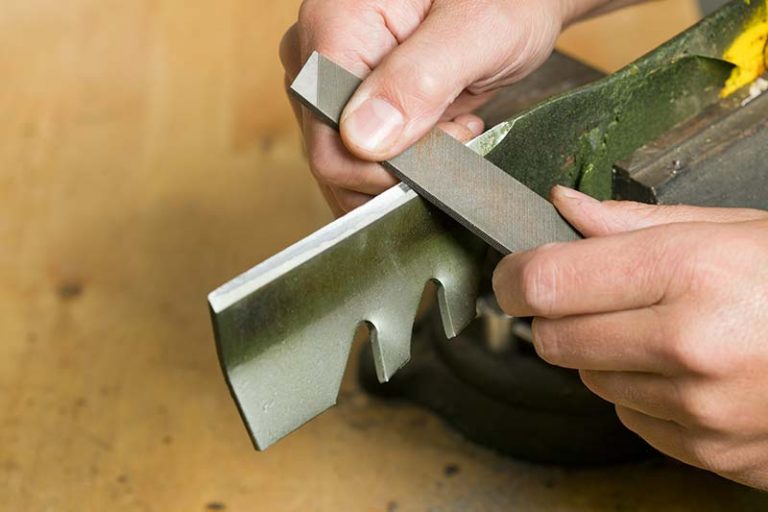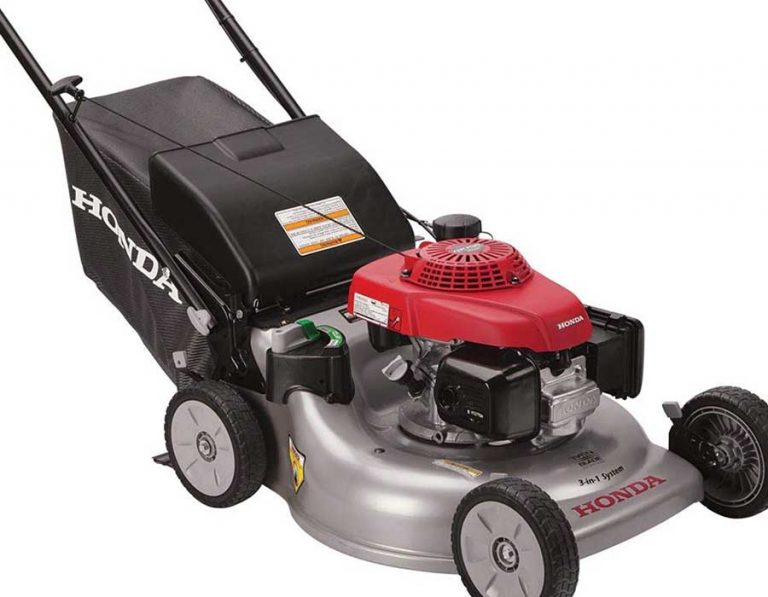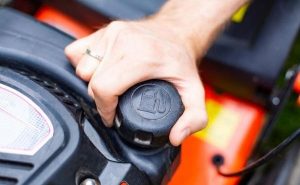Can Lawn Mowers Handle a Splash of Water?
Although they’re designed for outdoor use, lawn mowers are far from being waterproof. Whether it’s an electric or gas-powered mower, both have water-sensitive parts susceptible to damage if the mower is left or used in the rain.
In summary, you should avoid letting your lawn mower get wet whenever possible. Not only might you damage your mower, but mowing during wet conditions can also be a highly hazardous act for your own health. On top of this, it’s always inadvisable to mow a wet lawn to avoid damaging your turf or grass plants.
Can Lawn Mowers Get Wet?
The short answer is yes, lawn mowers can get wet to an extent without suffering any major issues. They are typically hardy pieces of equipment that are designed to be used outdoors. With that said, water can still interfere with your gas or electric lawn mower in several ways, and there is a limit to how wet some of the mowers parts can get before the mower will fail to start. We explore the issues surrounding using lawn mowers in wet conditions later in this article.
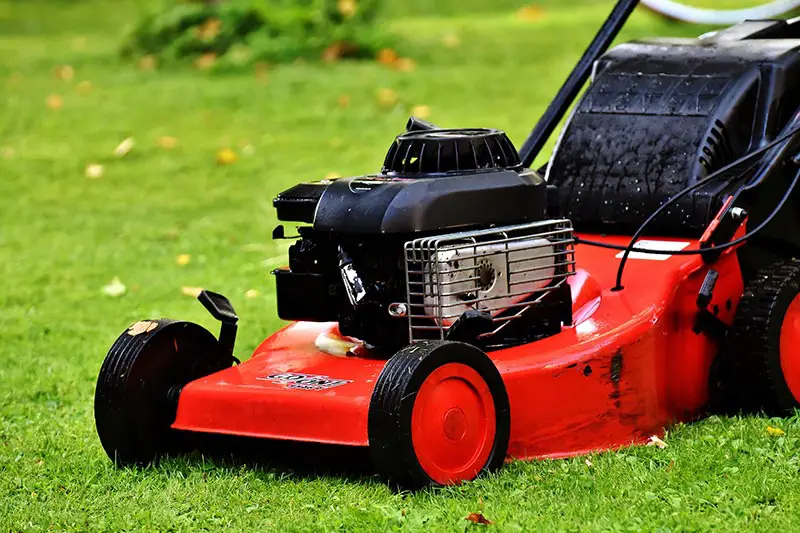
What Causes a Lawn Mower to Get Wet?
There are a few different ways that you can inadvertently introduce water to your lawn mower’s parts. This could be down to using the mower during a rainy period, storing the mower outside, or the mower having superficial damage to its deck or tank.
Rainfall
Rainfall is the most typical way that your lawn mower can get wet. Using your mower in the rain is highly inadvisable, for the sake of both your mower and grass.
Wet clippings can clog up the mower’s blades, causing it to stall. If you run the mower through a puddle, water may splash onto the mower’s engine block; when the engine block is hot, it is prone to damage from the cool water. Basically, cutting the grass during or right after a big rain leaves many parts of the mower highly vulnerable to water damage.
Storage of Lawn Mower
How you store your lawn mower will influence the likelihood of it getting wet. Obviously, storing your lawn mower outside leaves it more vulnerable to getting wet if it starts to rain. Even if it doesn’t rain, condensation from morning dew can also make the mower wet.
If you’re storing the mower indoors but you keep it under plastic sheeting, this sheeting can trap condensation and moisture. In addition to this, storing a gas-powered mower for long periods of time without using a fuel stabilizer leaves the fuel vulnerable to water contamination.
Mower Having Superficial Damage
Water may get into your lawn mower if it has superficial damage to its deck or fuel tank. Mowers are generally designed to be somewhat water-resistant, as they’re intended for outdoor usage. However, if parts of your mower such as its deck or fuel tank have cracks or dents, the internal workings of the mower become exposed to potential water damage.
Washing Lawn Mower
You may accidentally get the wrong parts of your mower wet when washing it. It’s important to clean your lawn mower after every use to prevent old decaying grass clippings from damaging its metal components.
You can do this by hosing it down, however, you must be careful not to get water on the engine, its cables, transmission lines, or belts; water causes these parts to rust before they eventually bind and break. As an additional note, you should never use a pressure washer to clean your mower; this is a guaranteed way to give the mower’s internal workings severe water damage.
Can You Mow the Lawn When it’s Raining?
No, you should never mow the lawn when it’s raining, nor should you directly after a heavy rain. This is bad for your lawn mower, as being potentially harmful to the health of you and your grass.
As we’ve already mentioned, mowing wet grass puts several parts of your lawn mower at risk of water damage. The wet grass clippings are highly prone to clogging the mower’s parts, particularly its blades. If these parts are weighed down with wet, heavy clippings, it can cause the mower engine to stall or overheat. Mowing while it’s actively raining leaves the mower’s internal parts vulnerable to any rainfall that trickles into its inner workings.
In addition to the mower, you can damage your grass by mowing it during or after a heavy rain. Because the rainfall weighs down the grass blades, you’ll likely end up with an uneven cut when the grass dries out. On top of this, mowing when the ground is soggy and muddy can create divots in the soil surface; this leaves you with an uneven lawn that is prone to standing water and drainage issues. The knock-on effect of all of these symptoms is that your lawn is then more vulnerable to the spread of fungal lawn disease.
Aside from the damage it can do to your mower and grass, mowing in the rain is hazardous to your health too. Wet grass is extremely slippery, and one dreads to think what could happen if you slipped while operating a dangerous piece of equipment like a lawn mower. You also put yourself at risk of receiving a nasty electric shock.
How Soon Can You Mow the Lawn After Rain?
After it rains, you can mow the lawn as soon as the turf is sufficiently dry. How long it takes for your lawn to dry out will depend on how much it rained and the drainage situation of your soil.
After mild morning dew or a light rain, it should be safe to mow the lawn within 2 to 5 hours.
After heavier rainfall, you should wait at least one full day before mowing.
As a rough test to determine whether your lawn is dry enough to mow, walk through the lawn after it has been raining. Take a look at your shoes; if they’re wet, then the lawn is still too wet to mow. If they’re dry, or only very lightly dusted with water, it’s probably safe to mow the lawn. As best practice, you should wait until the lawn is fully dry before attempting to mow it.
What Parts Can Get Wet On a Lawn Mower?
Some parts of the lawn mower are more sensitive to water damage than others. The most vulnerable parts of the lawn mower include its spark plug, carburetor, air filter, and fuel tank. On an electric lawn mower, the parts highly sensitive to water include its motor and battery.
Wheels, Deck, and Handles
The wheels, deck, and handle on your lawn mower are the parts most resistant to the effects of water. Even though these parts can handle getting wet, repeated exposure to water will cause them to rust over time.
Fuel and Oil Tank
If you have a gas-powered mower, you’ll be familiar with its gas and oil tanks. These parts store the mower’s gas and oil before it passes through the carburetor into the engine. Small cracks to either of these tanks will allow moisture or water to contaminate the fuel or oil. In turn, this can cause corrosion throughout the mower’s fuel system into its engine.
Air Filter
The lawn mower’s air filter is responsible for cleaning the air before it passes through the carburetor and the engine’s combustion chamber. It prevents impurities and particles from entering the inner workings of the mower where they may cause damage. If this part gets soaked with water, it will become clogged, inhibiting the flow of air into the engine. This will prevent your lawn mower from running properly until the air filter dries out.
Carburetor
The carburetor is the part of your lawn mower that mixes air and fuel in the correct proportion for combustion. The carb then channels this mixture into the engine for the spark plug to ignite it. If water makes it into the carburetor, its next stop is to infiltrate the mower’s engine. This can cause the engine to knock, corrode, and potentially break down entirely.
Spark Plug
The spark plug on your lawn mower is the part that ignites the air-fuel mixture in the mower’s engine. In turn, this creates the explosion necessary to power the mower. Exposure to water can corrode the spark plug, causing you difficulty when you next attempt to start the mower up. To fix a corroded spark plug, you’ll need to remove it and clean it. You should do this using steel wool and a specialized spark plug cleaner.
Electric Components (Electric Mower)
Electric lawn mowers are the type of mower most vulnerable to the damaging effects of water. From its motor to its battery, all electrical components of an electric mower are sensitive to water. Not only will water interfere with the operation of these parts, there is also the risk of you receiving an electric shock if you use a wet electric mower. For this reason, you should always take extra care to only use an electric mower when it’s completely dry.
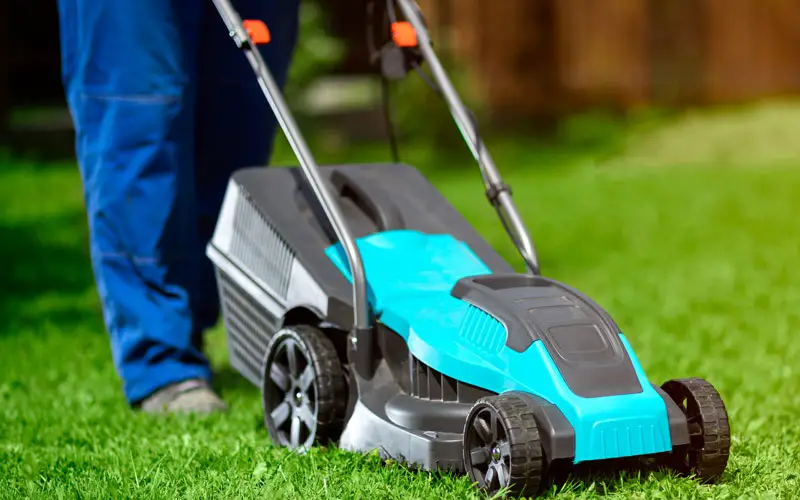
Can Electric Lawn Mowers Get Wet?
Electric lawn mowers are the most sensitive to water damage due to the nature of their components. You should never use an electric lawn mower during or straight after rainfall for the safety of you and your mower.
What to Do With a Wet Electric Lawn Mower
If your electric lawn mower gets wet in any way, follow these steps to minimize the potential water damage:
1. Do not start the mower when it is wet to any extent. Doing so could damage the mower, cause it to short circuit, or give you an electric shock.
2. Disconnect the mower from its power source and remove its battery.
3. Let the mower air dry for at least 24 hours.
4. After at least a day, use a blow dryer on the motor to dry off any remaining moisture.
5. Check electric connectors for corrosion, including the battery terminals. Clean off any corrosion using a suitable electric contact cleaner.
6. Test the components to ensure they’re working properly using a multi-meter.
7. If all components are working properly, reconnect the battery/power source and start the mower as normal.
Can Gas Powered Lawn Mowers Get Wet?
Gas-powered lawn mowers are slightly more resistant to water damage than electric lawn mowers. With that said, there are still many parts of a gas-powered lawn mower that can be affected by water or moisture.
What to Do with a Wet Gas-Powered Lawn Mower
Follow these steps if you suspect your gas-powered lawn mower has been contaminated with water.
1. Allow the mower to fully air dry for a minimum of 24 hours.
2. After 24 hours, turn on the mower’s engine. The heat that the engine generates will help the rest of the parts to dry out.
3. Check the lawn mower’s fuel tank for water contamination. If the fuel is contaminated with water, drain and refill the mower with fresh gas. Make sure to responsibly dispose of the old fuel.
4. Next, check the lawn mower’s oil tank for water contamination too. If the oil appears contaminated, i.e. it looks milky, drain it and refill the tank with fresh oil.
5. Remove and drain the mower’s carburetor. Clean it and allow it to fully air dry before replacing it in the mower.
6. Remove the mower’s air filter. Clean the filter and allow it to dry, then spray it with a little oil before replacing it.
Troubleshooting a Gas-Powered Lawn Mower That Fails to Start from Getting Wet
If one or more parts of your gas-powered mower are significantly affected by water, it will fail to start. Follow through these troubleshooting steps to identify which part of your mower is causing the issue.
1. Check Spark Plug
First, you should check the mower’s spark plug; even a slight amount of moisture may prevent the spark plug from sparking the mower’s fuel. The spark plug should be located on the side or back of your mower’s engine.
If the spark plug seems to be wet or dirty, you’ll need to clean it off and dry it out. Remove the spark plug, then use some sandpaper to remove any residues from it. Allow the spark plug to fully air dry before replacing it in the lawn mower. Make sure there is enough space between the spark plug and its electrode.
When the spark plug is clean and dry and back in position, attempt to start your mower. If it fails to start, move on to the next step.
2. Check Air Filter
The part you need to check is the mower’s air filter. This is typically found near the top of the engine, housed in a metal or plastic encasement.
Assess the air filter’s condition; if it seems to be damp or overly wet, you need to allow it to dry out before cleaning it and replacing it into the mower. If it seems severely dirty or worn out, it may be best to replace the air filter completely.
Once the clean, dry air filter is back in place, try starting your mower again. If it’s still failing to start, try the last step.
3. Check Fuel Tank and Carburetor
The last parts you should diagnose for water contamination are the mower’s fuel tank and carburetor.
Drain the gas from the mower’s fuel tank into a clean container to assess whether it’s contaminated with water. You’ll be able to tell if there’s water in the gas as it will form tiny bubbles, appearing similar to the behavior of cooking oil in water. As water is heavier than gas, the bubbles will be trapped at the bottom of the fuel.
In the case that you do find water in the fuel, you’re going to have to dismantle every part of the lawn mower to allow it all to dry out. This includes removing the mower’s top cover, fuel tank, carburetor, and air filter. Clean the parts and leave them to air dry before replacing them into the mower.
Once the parts are back in the mower, refill the fuel tank with fresh gas. An obvious tip, but ensure that the new fuel is uncontaminated with water. Attempt to start the mower – it should now be working as normal. If not, you will likely need to send it to a professional mechanic to diagnose and repair it.

